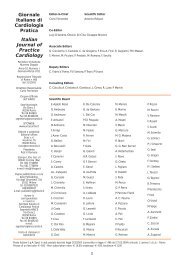Scarica il documento in formato pdf (574 KB - ANCE
Scarica il documento in formato pdf (574 KB - ANCE
Scarica il documento in formato pdf (574 KB - ANCE
Create successful ePaper yourself
Turn your PDF publications into a flip-book with our unique Google optimized e-Paper software.
Precocità degli <strong>in</strong>terventi preventivi:<br />
la prevenzione cardiovascolare deve<br />
com<strong>in</strong>ciare dai bamb<strong>in</strong>i delle scuole elementari<br />
The adoption of early preventive measures:<br />
cardiovascular prevention must start with Junior<br />
School ch<strong>il</strong>dren<br />
C. Poli<br />
Proviamo a parlare di prevenzione ad un bamb<strong>in</strong>o, <strong>in</strong> maniera chiara e semplice: «...Sai cosa vuol dire “prevenire”? Prevenire vuol<br />
dire che se ci comportiamo <strong>in</strong> maniera giusta prima, dopo non succedono guai o almeno ne succedono meno... Le malattie si possono<br />
prevenire ma dobbiamo <strong>in</strong>iziare subito per evitare di rov<strong>in</strong>are l’organismo quando ancora è sanissimo, cioè quando siamo bamb<strong>in</strong>i».<br />
Questo concetto è ormai basato su evidenze scientifiche. A Monaco di Baviera uno studio prospettico su 3300 bamb<strong>in</strong>i/adolescenti<br />
e sulle loro famiglie ha mostrato che l’<strong>in</strong>cidenza di alcuni fattori di rischio è la stessa fra bamb<strong>in</strong>i ed adulti: qu<strong>in</strong>di da una parte è<br />
un errore pensare che i bamb<strong>in</strong>i siano esenti dai fattori di rischio cardiovascolari, dall’altro non si deve parlare più di <strong>in</strong>dividui a<br />
rischio, ma di famiglie a rischio. I fattori di rischio che creano danni all'organismo f<strong>in</strong> dall'<strong>in</strong>fanzia sono almeno 7, ed usando parole<br />
adatte all’età li possiamo chiamare “I 7 Cavalieri neri del cuore”: obesità, che non solo è strettamente legata alla sedentarietà (troppa<br />
TV!), all’iperlipemia, all’ipertensione ed alla ridotta tolleranza al glucosio, ma è legata anche a seri problemi psicosociali: <strong>il</strong> bamb<strong>in</strong>o<br />
obeso spesso è isolato e preso <strong>in</strong> giro dai compagni, e per risposta mangia ancora di più, e male! Inf<strong>in</strong>e c’è lo stress (sì, anche nei<br />
bamb<strong>in</strong>i) ed <strong>il</strong> fumo: tra <strong>il</strong> 30 ed <strong>il</strong> 40% dei bamb<strong>in</strong>i sono fumatori passivi! Per ridurre <strong>il</strong> rischio che i nostri figli un domani si<br />
ammal<strong>in</strong>o dobbiamo modificare lo st<strong>il</strong>e di vita delle famiglie oggi, e questo si può fare solo rivolgendoci ai componenti più<br />
giovani della famiglia stessa. Infatti è diffic<strong>il</strong>e, faticoso e spesso <strong>in</strong>ut<strong>il</strong>e dare buone abitud<strong>in</strong>i a chi ha già da tempo imparato le<br />
cattive abitud<strong>in</strong>i, cioè agli adulti, mentre è fac<strong>il</strong>e e soprattutto ut<strong>il</strong>e dare buone abitud<strong>in</strong>i di vita a chi ancora non ha abitud<strong>in</strong>i, cioè<br />
ai bamb<strong>in</strong>i. In conclusione: “Per combattere i nemici della salute non sono necessarie le medic<strong>in</strong>e, ma basta prendere delle buone<br />
abitud<strong>in</strong>i f<strong>in</strong> da giovani: <strong>il</strong> vostro cuore e i vostri polmoni vi r<strong>in</strong>grazieranno, tantissimo, non ammalandosi”.<br />
Let us try to talk about prevention to a ch<strong>il</strong>d, <strong>in</strong> a clear and simple way: «...Do you know what “to prevent” means? It means that if we<br />
behave correctly <strong>in</strong> the first place, we w<strong>il</strong>l not get <strong>in</strong>to trouble afterwards, or at least we w<strong>il</strong>l get <strong>in</strong>to lesser trouble...» The onset of diseases<br />
can be prevented as long as we take proper measures to preserve our health when our organism is healthy, i.e. when we are ch<strong>il</strong>dren.<br />
This concept is based on scientific evidence. A perspective study carried out <strong>in</strong> Munich on 3300 ch<strong>il</strong>dren\adolescents and their fam<strong>il</strong>ies<br />
has showed that the <strong>in</strong>cidence of certa<strong>in</strong> risk factors important <strong>in</strong> adulthood is just as crucial <strong>in</strong> ch<strong>il</strong>dren: therefore, <strong>in</strong> the first place, it is<br />
wrong to assume that ch<strong>il</strong>dren are free from cardiovascular risk factors and, <strong>in</strong> the second place, our attention should be focused on<br />
fam<strong>il</strong>ies at risk rather than on <strong>in</strong>dividuals at risk. The risk factors affect<strong>in</strong>g the health of our organism beg<strong>in</strong>n<strong>in</strong>g from early ch<strong>il</strong>dhood<br />
are at least 7 and, us<strong>in</strong>g words proper for that age, could be def<strong>in</strong>ed as “The 7 Black Heart Knights”: obesity, which is not only closely<br />
connected with a sedentary life style (too much TV!), with hyperlipemia, with hypertension, and with reduced glucose tolerance, but<br />
also with serious psychosocial problems – an obese ch<strong>il</strong>d is often isolated and laughed at by his playmates, which makes him eat even<br />
more and, worse st<strong>il</strong>l, unhealth<strong>il</strong>y. The other two risk factors are stress (yes, <strong>in</strong> ch<strong>il</strong>dren, too!) and smok<strong>in</strong>g: an estimated 30 to 40% of<br />
ch<strong>il</strong>dren are passive smokers. To reduce the future risk of cardiovascular diseases for our ch<strong>il</strong>dren, we must implement a fam<strong>il</strong>y-oriented<br />
prevention program to improve the lifestyle of today’s fam<strong>il</strong>ies, and this can only be done by address<strong>in</strong>g their youngest components.<br />
In fact, teach<strong>in</strong>g healthy habits to people who have been learn<strong>in</strong>g bad habits for their whole lifetime, i.e. adults, can be a difficult,<br />
tiresome, and often useless task, wh<strong>il</strong>e teach<strong>in</strong>g a healthy lifestyle to those who have not yet developed unhealthy habits, i.e. ch<strong>il</strong>dren,<br />
is very easy and, above all, very useful. In short: “No medic<strong>in</strong>es are required to overcome the enemies of health. All you have to do<br />
is adopt healthful habits ever s<strong>in</strong>ce ch<strong>il</strong>dhood: your heart and your lungs w<strong>il</strong>l be so grateful that they w<strong>il</strong>l not even get sick”.<br />
(It J Practice Cardiol 2003;1:17-20)<br />
Key words: preventive measures • cardiovascular prevention • primary school ch<strong>il</strong>dren<br />
© 2003 <strong>ANCE</strong> Ricevuto <strong>il</strong> 29 apr<strong>il</strong>e 2003; accettato l’1 luglio 2003.<br />
Cardiology and Anaesthesiology - Recovery Specialist<br />
Lead<strong>in</strong>g Physician Intensive Care Unit S. Maria Nuova Hospital Firenze Health Services<br />
Correspond<strong>in</strong>g author: Claudio Poli<br />
Via Garibaldi 12, 50123 Firenze - Tel. 055 290856, Cell. 338 2355529, E-ma<strong>il</strong>: claudio106@yahoo.it<br />
It J Practice Cardiol is ava<strong>il</strong>able at http://www.ancecardio.it<br />
17
















